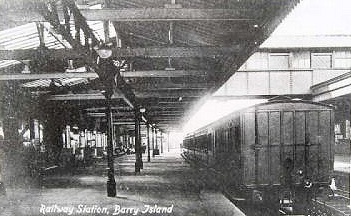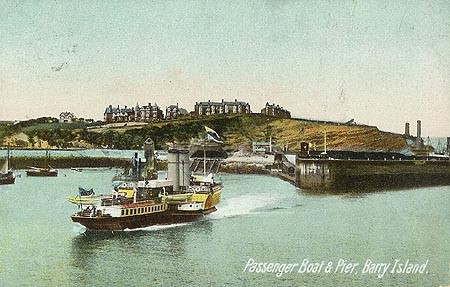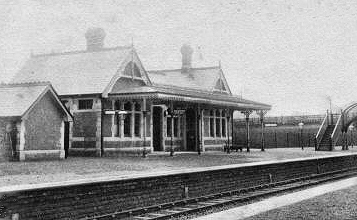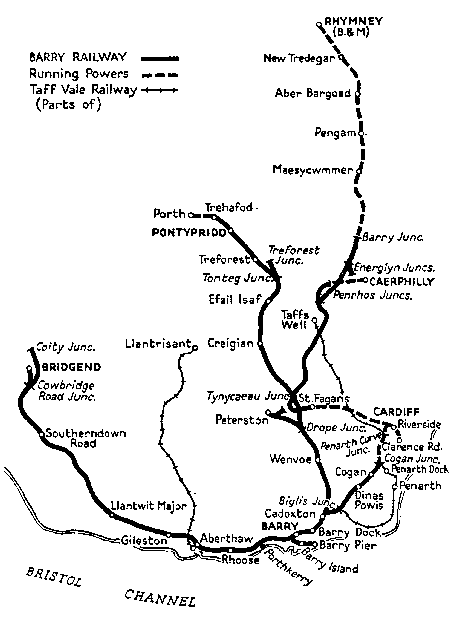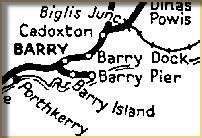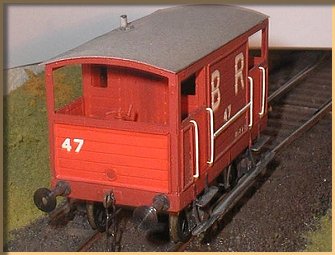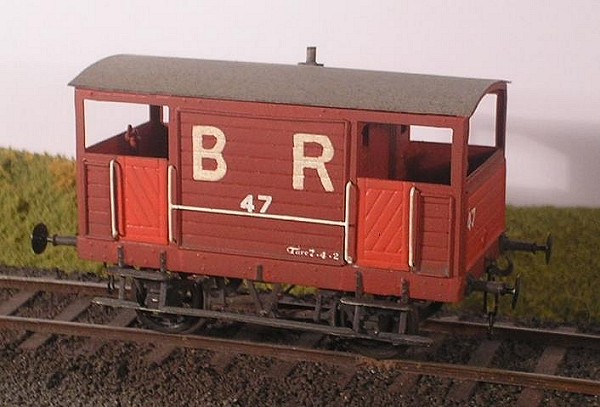|
Modelling the Barry Railway
compiled by Mikkel Kjartan
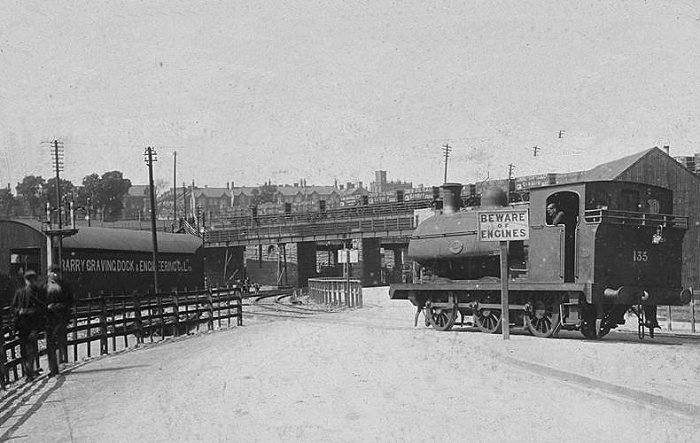
Introduction
The Barry Railway was one of the most financially succesful railways in South Wales. Unlike other lines in the area, the Barry controlled its own port, and followed a highly opportunistic strategy in developing its system – linking to other existing lines as a means of bringing coal into its system.
The Barry furthermore controlled the Vale of Glamorgan line from Barry to Bridgend, a picturesque passenger and minerals route that still exists today.
Modelling potential
The Barry is another of those rarely modelled South Wales railways, which is a pity as it has many interesting locations and scenarios for the modeller. These include:
* Barry docks – not necessarily the whole lot (!), there are plenty of options for a small-space layout showing a small section of the docks.
* Barry Island pier – this would make a novel layout featuring the passenger trains arriving on the pier, and maybe one of the Barry company's own steamers alongside. The pier also saw passenger stock from the other Welsh railways and the LNWR.
* The Vale of Glamorgan line – the stations on this line were of a characteristic yet fairly easily modelled design. Alternatively, stations on the Cadoxton–Trehafod line were also very characteristic, although of a more complex design (see photo on right).
* The engine shed at Coity – a small two-road shed that could display 2–3 interesting Barry locos. The Wills engine shed kit is quite similar.
* The Barry bay at Bridgend station – this was a very modellable bay in its early days, and could include all or sections of the GWR part of the station if you fancy a joint layout.
* St. Fagans exchange sidings, if you fancy a Barry/GWR joint layout with plenty of goods stock.
There are no RTR models of Barry Railway stock, but the page following lists and illustrates some of the available kits.
|
|
Books
D.S. Barrie
"The Barry Railway"
Oakwood Press, 1962
|
In-depth historical description of the Barry's development |
Trefor Jones, Mike Morton Lloyd and Rhobat Bryn Jones
Welsh Railway Records Volume 2 – Barry Railway Drawings |
144 pages, drawings of 19 locomotives, 2 motor cars, 14 coaches, 2 brake vans and wagons, with 80 photographs, together with livery and numbering details. |
E.R. Mountford
"GWR Absorbed Coaching Stock" (Barry section)
Oakwood Press, 1978
|
Includes lists of Barry absorbed stock and withdrawal dates |
E.R. Mountford
"The Barry Railway: Diagrams and photographs of Locomotives, Coaches and Wagons"
Oakwood Press, 1987
|
Drawings and photos of almost all Barry Railway locos, coaches and wagons |
J.N. Slinn
Great Western Way (section on Barry liveries)
Historical Model Railway Society, 1978 |
Includes several pages describing Barry liveries
|
Brian J. Miller
"Rails to Prosperity: The Barry & After"
Regional Publications Limited (Bristol), 1984
|
A miscellany of well-captioned photos from Barry days to the 1970s |
Vic Mitchell & Keith Smith
"Branclines around Barry"
Middleton Press, 2005
|
Captioned photos and maps of the Cardiff, Wenvoe, Penarth and Bridgend lines |
M.A. Tedstone
"The Barry Railway Steamers"
Oakwood Press, 2005
|
Hiostory and details on the Barry's steamers as used in the Bristol Channel |
Colin Chapman
"Vale of Glamorgan Railway"
Oakwood Press, 1998
|
Describes this line from Barry days until the 1990s. |
R.J. Rimell
"History of the Barry Railway Company 1884-1921"
Tudor Printing, 1923
|
Not seen. Could this include clues for the debate on Barry Railway liveries? |
Articles
The following list was from the excellent Magazine Digest on the Gauge O Guild website. Note that this facility lists subjects by original title of the articles, and hence the exact contents are not always specified.
| Title |
Content |
Scale |
Magazine |
Date |
Nigel Digby
"Liveries of the pre-grouping railways"
British Railway Modelling, July 2002 |
Article and colour artwork on Barry Railway liveries |
7mm |
Railway Modeller |
11/1977 |
| 10T Goods Wagon with Catch Trestle |
Drawing |
7mm |
Railway Modeller |
1/1978 |
| 10T Trestle Goods Wagon |
Drawing |
7mm |
Railway Modeller |
3/1979 |
| 10T Goods Van |
Drawing |
7mm |
Railway Modeller |
4/1978 |
| 37'9" 6-wheel 3rd Class Coach |
Drawing |
4mm |
Model Railway Constructor |
3/1970 |
| 37'9" 6-wheel 3rd composite coach |
Drawing |
4mm |
Model Railway Constructor |
3/1970 |
| 37'9" 6-wheel passenger brake van |
Drawing |
4mm |
Model Railway Constructor |
3/1970 |
| Bridgend Loco shed Parts 1–2 |
Drawing |
4mm |
Model Railways |
4&5/ 1977 |
Building a Barry Railway
0-6-4T Parts 1–3 |
Construction Article |
7mm |
Scale Model Trains |
11&12/ 1989; 1/1990 |
| Class B1 |
Drawing |
– |
Railway Modeller |
11/1987 |
| Class F (A) |
Drawing |
4mm |
Railway Modeller |
3/1989 |
| Class G |
Drawing |
4mm |
Railway Modeller |
1/1987 |
| Class H |
Drawing |
4mm |
Railway Modeller |
11/1986 |
| Class J |
Drawing |
4mm |
Railway Modeller |
10/1985 |
| Class L (A) |
Drawing |
4mm |
Railway Modeller |
1/1992 |
| Class K (Cooke) |
Drawing |
4mm |
Model Railways |
12/1977 |
| Heavy Tank Engine Parts 1–2 |
Construction Article |
7mm |
Scale Model Trains |
10/1989 |
| Layouts for Operation: Barry Railway |
Article |
– |
Model Railway Journal |
No 131 |
Links
Barry Railway liveries
Stock colours
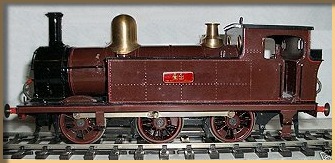
Barry Railway Class A – sporting one interpretation of the Barry livery. This is a 7mm model built from a Gladiator kit. Note that the flash effect has an impact on these photos: The colours seen here are indicative only.
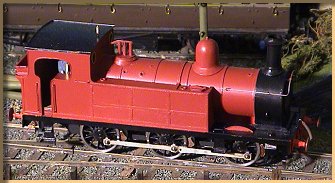
Another Class A, with an alternative interpretation of the livery shade. This 7mm model was scratchbuilt in Plastikard by Brian Bunce. The undercoat is red oxide. Photo courtesy Barry & Penarth Model Railway Club. |
There is some debate over the exact shade of the Barry Railway livery, and whether or not it differed between locos, coaches and wagons.
On the issue of shade, the question is whether locos and stock carried a dark Chocolate Lake or a lighter Crimson Lake (akin to e.g. Midland Red) – and whether there was a gradual change over time, or the same colour throughout.
The issue is not made any easier by the fact that lining styles and colours also changed over the years, which may well have affected the impression of shade – along with oil cleaning and the fact that red is a very difficult colour to judge in black and white photos.
The table at the bottom of this page lists the main sources I have been able to dig up on stock colours. Slinn's account is the most detailed, while Nigel Digby's article in British Railway Modelling is the only one that seeks to illustrate the livery in colour artwork.
Both Slinn & Digby lean towards the darker shade, and this is also the impression one gets from studying photographs in E.R. Mountford's book.
Further views on the matter have been recieved via e-mails. This includes the following comments by David Temple of the Barry & Penarth MRC: "I think it is impossible to find the actual colour now. I have decided that Humbrol No 73 is about right. My 6-wheel coaches from Redcraft are painted in this colour, which is not quite as crimson as Midland Red."
Also on this issue, Brian Watson writes: "Back in the 1980's I scratchbuilt a Barry Railway class 'G' 0-4-4 tank. I eventually became a member of the Welsh Railways Research Circle (no longer a member) and showed the engine to the late C. Donovon, at that time a recognised expert of the Barry. Now my initial colour for the Barry tank was a concoction that I mixed up trying to replicate Cadburys Bourneville chocolate with a slight reddish tinge. I don't think Dr. Donovon was too impressed and suggested I used something similar to the MR crimson. My repaint was basically MR crimson, but on top of the original home made chocolate colour, which thereby served as a darker undercoat. Dr. Donovon was pleased with the resulting colour and thought it was a good likeness. It remains that colour to this day."
Lining and insignia
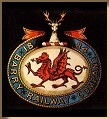
Later Garter Crest
|
The following is based on J.N. Slinn's Great Western Way;. Please note this is only an overview, see Slinn for more details.
Locos
From 1905–1910 both passenger locos and goods engines were lined. Before and after that, only passenger class carried lining.
Lining included a broad scarlet band around edges of tank and cab sides. Inside and separate from this, the lining proper consisted of a black band edged with thin yellow line on either side. This was also applied to boiler bands. From 1905, the black band was changed to green. The scarlet and black bands is not visible on post-WWI photos.
Passenger locos had dome covers and safety valve bases in polished brass. On goods engines they were painted over (except 1905–1910).
| This photo of a Class F in works grey illustrates the broad scarlet band on cab and tank sides, and the lining inside it. Source: Author's collection |
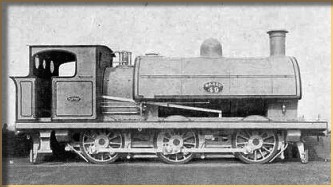 |
Until c WWI locos (including goods) carried Garter crest on bunker sides. An early version showing an intertwined 'BR' was replaced in 1905 by the dragon design (illustrated).
All locos carried brass numberplates of various designs in the centre of tank sides. Numerals were also carried on loco fronts, first as separate brass numerals on chimney, later as number plates on chimney or smokebox.
Passenger stock
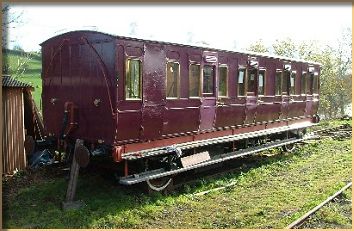
Barry Railway 6-wheel composite to Diagram 5 undergoing restoration. Note the livery shade. |
Paneling was lined with thin chrome yellow on either side of mouldings. Droplight frames were in polished mahogany. Lettering and numbers in gold shaded mid-blue.
Class wording was originally in blocks in waist below door droplights, but this was later changed to large numerals in lower door panels.
Crest appeared twice on body sides, evenly spaced, except for brake thirds which had a garter at the van end only.
When repainting after grouping, the GWR painted on standard GWR panels regardless of actual mouldings on the Barry coaches, resulting in a rather bizarre appearance.
Goods stock
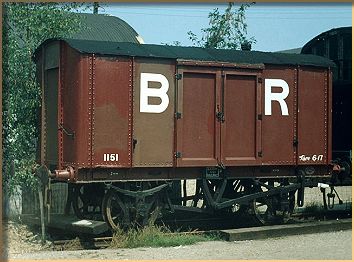
Barry Railway Iron Mink at Tenterden station in 1980. Photo courtesy and copyright David Wainwright.
|
Original lettering was in white unshaded 5" blocks, carried on second plank down from top (both vans and wagons), showing 'Barry' and 'Co.' on each side of doors.
Post WWI insignia altered to simply 'BR' on either side of doors, in white 24" blocks (as illustrated).
Sources on stock colours
| Source |
Locos |
Passenger stock |
Freight stock |
J.N. Slinn
"Great Western Way" Historical Model Railway Society, 1978 p. 189–196
|
Chocolate brown at first, changing to richer shade after 1905. Darkened further after 1910 to become Lake. Smokeboxes and chimneys black. Chimneys copper-capped throughout. Underframe as body. Wheels as body until 1905, then black. |
Crimson lake bodies. Roofs white with black fittings. Solebars and wheel centers crimson lake until c 1900, then black. |
Red oxide sides and ends. Solebars as body if wood, otherwise black. All strappings, hinges and underframe detail black (except possibly leaf springs). Brake vans as above but with vermillion ends, and after WWI also with vermillion side doors on verandhas. |
E.R. Mountford
"The Barry Railway: Diagrams and photographs of Locomotives, Coaches and Wagons"
Oakwood Press, 1987 p. 6 |
Chocolate in the "early days", Lake in "later days". |
As locos |
"Generally" Lake |
E.R. Mountford
"GWR Absorbed Coaching Stock" (Barry section)
Oakwood Press, 1978 p. 33 |
Not mentioned |
"The official colour of Barry coaching stock was Lake with gold lining, but the shade varied over the years according to the quantity of red put in the individual mix" |
Not mentioned |
D.S. Barrie
"The Barry Railway"
Oakwood Press, 1962 p. 196 & 203
|
"Crimson-chocolate" |
"Reddish or lake colour, generally similar to that of the engines" |
Not mentioned |
Nigel Digby
"Liveries of the pre-grouping railways"
British Railway Modelling, July 2002 |
"Dark crimson brown" |
As locos |
Brown oxide (very similar to locos) |
Barry & Penarth MRC 7mm locos
These locos are part of the Welsh loco stud running on Tafsil, a Welsh 7mm layout by the Barry & Penarth Model Railway Club. Thanks to David Temple for use of the images, which are copyright of the Barry & Penarth MRC.
| 7mm Barry Railway Class G, scratchbuilt by Brian Bunce |
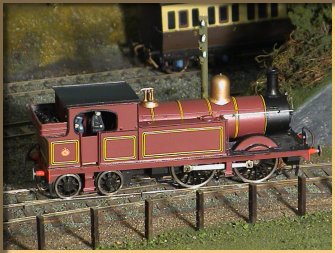
|
| 7mm Barry Railway Class J, built from a Redcraft kit by Derek Harris |
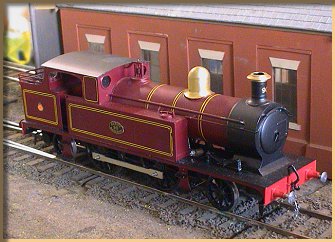
|
| 7mm Ex-Barry Railway Class C No 1322 in GWR guise, built by Brian Bunce |
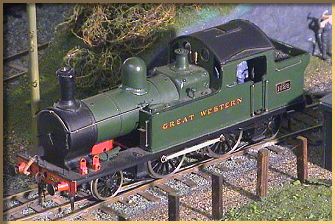 |
Redcraft 7mm Barry Railway stock
Here is a taste of the range of intriguing Welsh loco and coach kits from the former Gateneal range – and subsequently marketed and expanded by Redcraft Engineering. Images courtesy and copyright Redcraft Ltd.
| 7mm Barry Railway Class F |
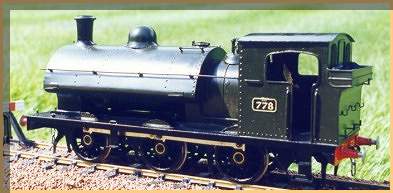
|
| 7mm Barry 4- and 6-wheel coaches in GWR livery |
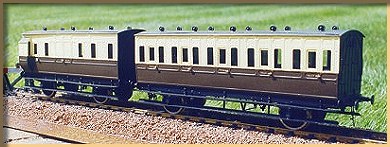
|
| 7mm Barry Railway Class B1 |
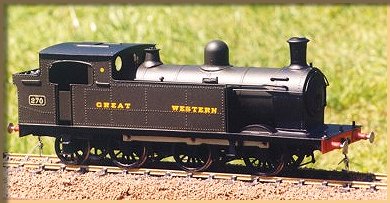 |
Barry Railway heavy haulers
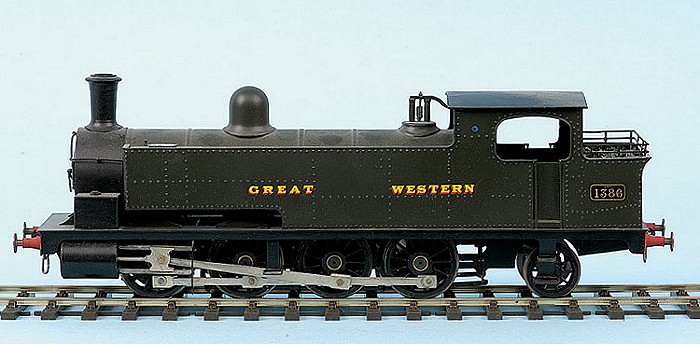 | 7mm Class H in GWR guise, built from a Redcraft kit. Photo courtesy Vectis Auctions. |
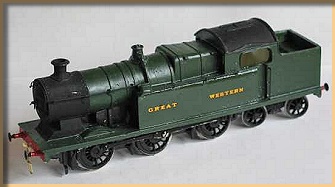 | 4mm Class L in GWR rebuilt condition. Built by Graeme Pettit using the Dean Sidings kit and Hornby 0-6-0 chassis. You can see Graeme's notes on this kit in the GWR Projects section. |
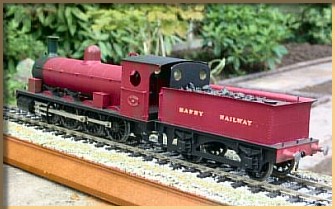 | 7mm Barry Railway Class D, believed to be scratchbuilt.
courtesy Terry Smith of TMS models. |
Barry Railway goods stock models
| 7mm Twin Mites, built from a Dragon Models kit by Raymond Walley.. |
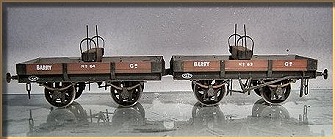 |
Disused Barry Railway structures
The following photos were provided by the now-defunct CardiffRail Website, which provided photographic 'trackbed guides' to some of the abandoned South Wales lines, including those of the Barry. All photos copyright CardiffRail.
| Long-lost jungle temple? The South abutment of Penhros Viaduct. |
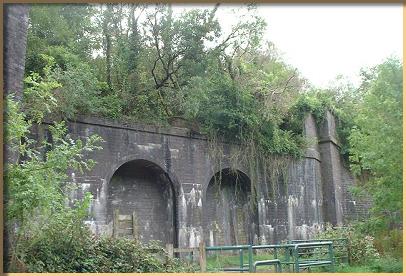
|
| Begging to be modelled, a footpath bridge near Stockland Farm on the Barry to Llanbradach line. |
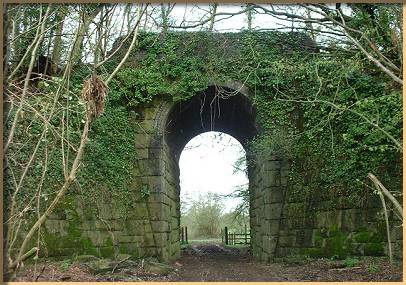
|
| This too shall pass. The down platform of what was once Creigiau station. |
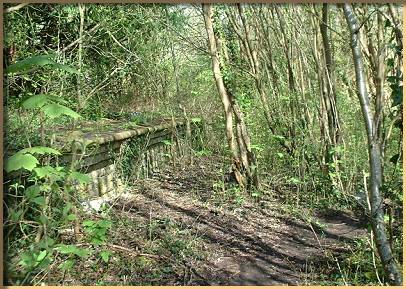 |
|

